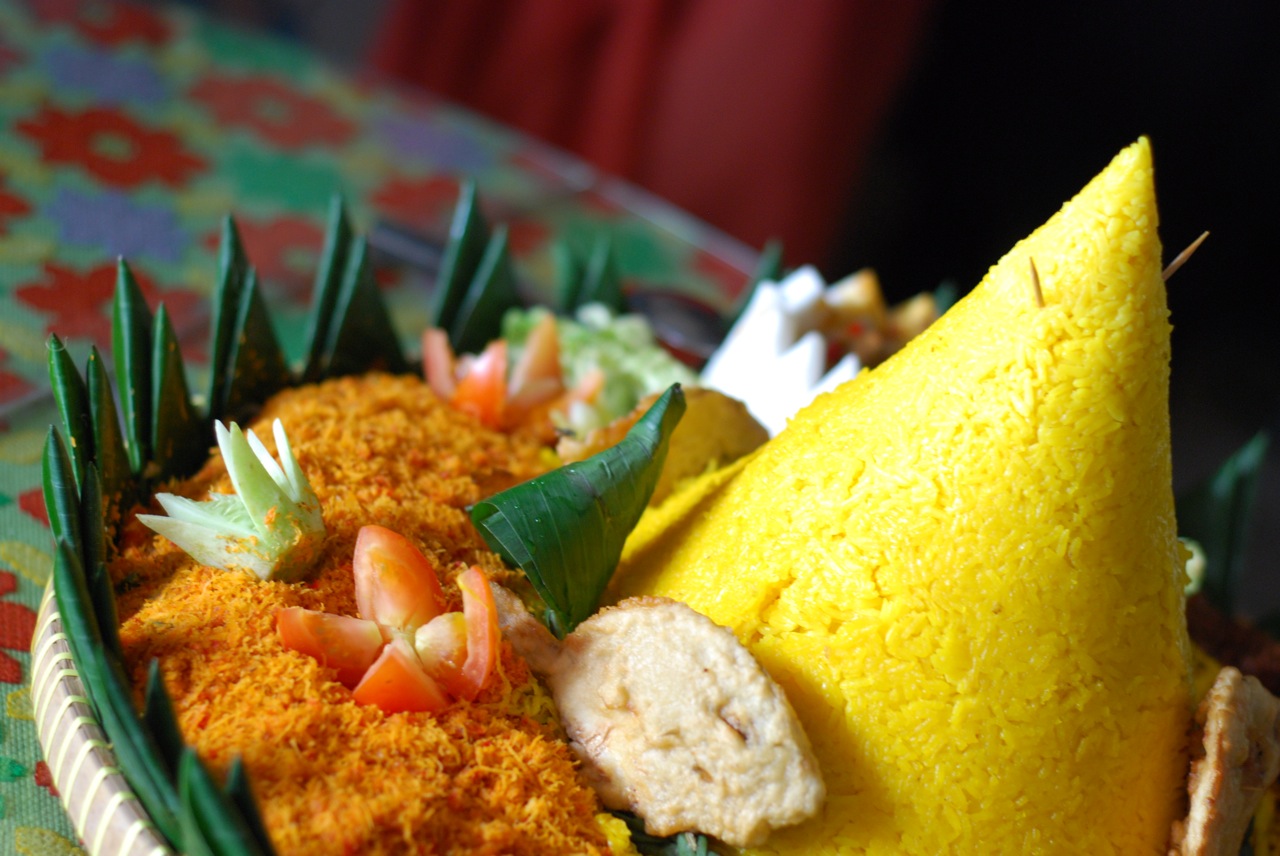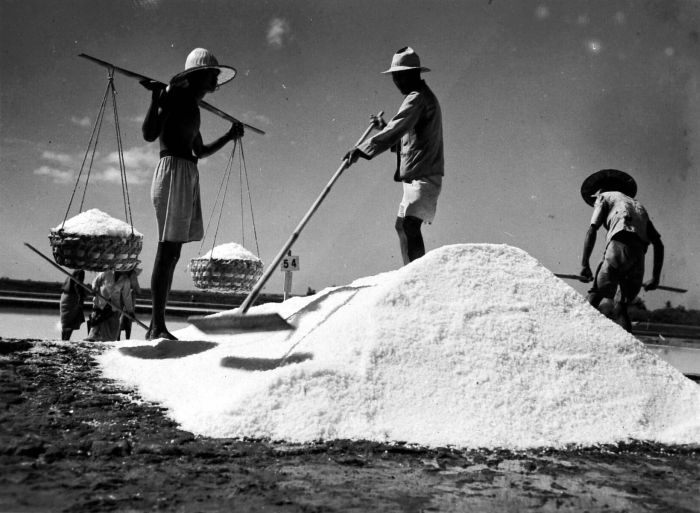|
Tumpeng
Tumpeng ( Javanese: ; Balinese: ) is an Indonesian cone-shaped rice dish with side dishes of vegetables and meat originating from Javanese cuisine of Indonesia. Traditionally featured in the '' slamatan'' ceremony, the rice is made by using a cone-shaped woven bamboo container. The rice itself may be plain steamed rice, uduk rice (cooked with coconut milk), or yellow rice (uduk rice colored with ''kunyit'' (turmeric)). The rice cone is erected in the (rounded woven bamboo container), covered with a banana leaf, and surrounded by assorted Indonesian dishes. In 2013, the Indonesian Ministry of Tourism and Creative Economy promoted tumpeng as one of 30 Indonesian culinary icons and gave it the status of official national dish of Indonesia in 2014, describing it as "the dish that binds the diversity of Indonesian various culinary traditions." History and tradition People in Java, Bali and Madura usually make tumpeng to celebrate important events. However, all Indonesians are f ... [...More Info...] [...Related Items...] OR: [Wikipedia] [Google] [Baidu] |
Indonesian Cuisine
Indonesian cuisine is a collection of various regional culinary traditions that formed the archipelagic nation of Indonesia. There are a wide variety of recipes and cuisines in part because Indonesia is composed of approximately 6,000 populated islands of the total 17,508 in the world's largest archipelago,"Indonesian Cuisine." . Accessed July 2011. [...More Info...] [...Related Items...] OR: [Wikipedia] [Google] [Baidu] |
Nasi Kuning
Nasi kuning (Indonesian for: " yellow rice"), or sometimes called nasi kunyit (Indonesian for: "turmeric rice"), is an Indonesian fragrant rice dish cooked with coconut milk and turmeric, hence the name ''nasi kuning'' (yellow rice). In the Philippines, a related dish exists in Mindanao, particularly among the Maranao people, where it is known as ''kuning''. Like the Indonesian version, it primarily uses turmeric, but also adds lemongrass and does not use coconut milk. A similar dish is also found in Sri Lankan cuisine where it is known as ''kaha buth'' (and Lamprais) and draws from both Indonesian and Sri Lankan influences. Cultural significance In Indonesian culture, nasi kuning has favourable symbolic meanings. The yellow-coloured rice is perceived to look like a pile of gold, so it is often served in festive occasions; including parties, housewarmings, welcoming guests and opening ceremonies – as a symbol of good fortune, prosperity, wealth and dignity. Nasi kuning i ... [...More Info...] [...Related Items...] OR: [Wikipedia] [Google] [Baidu] |
Javanese Cuisine
Javanese cuisine is the cuisine of Javanese people, a major ethnic group in Indonesia, more precisely the province of Central Java, Yogyakarta and East Java. Definition Javanese cuisine refers exclusively to the cuisine of Javanese people, which is often brought to other regions and countries by Javanese diaspora or foreign descents who have lived in Java. There are several native ethnic groups who live on the island of Java (Sundanese, Madurese, Betawi, etc.) as well as other peoples of foreign descents. In Indonesian language, Javanese refers to people of Javanese ethnic background. Javanese cuisine is thought to be sweet, since this is the taste traditionally preferred in Yogyakarta. However, Javanese regions do not only include Yogyakarta. On the northern and northeastern of Central Java, for instance, the taste tend to be salty and spicy. In East Java, the level of spiciness increases. Today, as Javanese people become more mobile and may move to different regions ... [...More Info...] [...Related Items...] OR: [Wikipedia] [Google] [Baidu] |
Nasi Uduk
''Nasi uduk'' (Indonesian: "''nasi'' ''uduk''") is an Indonesian style steamed rice cooked in coconut milk dish, especially popular in Betawi cuisine. Etymology According to the book "Kuliner Betawi Selaksa Rasa & Cerita" (2016) composed by Akademi Kuliner Indonesia, the term ''uduk'' etymology derived from the term that means "difficult" or "struggle", which suggested that this rice dish was originally consumed by farmers and hard labourers. Another theory suggests that the term ''uduk'' is related to the term ''aduk'' which means "mix", thus nasi uduk means "mixed rice". On the other hand, some people connected the etymology to the Javanese traditions. Sultan Agung of Mataram called this rice dish ''wuduk,'' from Arabic word ''tawadhu which means being humble before God''.'' Depending on the dialect used, it can be referred to as ''uduk'' or ''wuduk'' in Javanese. When a reference to its taste is made, it's called ''sega gurih'' (lit. savory rice). History According to ... [...More Info...] [...Related Items...] OR: [Wikipedia] [Google] [Baidu] |
Urap
''Urap'' (sometimes spelled ''urab'' or in its plural form ''urap-urap'') is a salad dish of steamed vegetables mixed with seasoned and spiced grated coconut for dressing. It is commonly found in Indonesian cuisine, more precisely Javanese cuisine. ''Urap'' can be consumed on its own as a salad for vegetarian meals or as a side dish. ''Urap'' is usually found as a prerequisite side dish of Javanese ''tumpeng'', a cone shaped rice mound surrounded with assorted dishes, as well as part of a '' nasi kuning'' dish. In Balinese cuisine it is known as Urab sayur. Ingredients The vegetables which are usually used in ''urap'' are spinach, water spinach, young cassava leaf, papaya leaf, Chinese longbeans, bean sprouts and cabbage. To acquire a rich taste, most recipes insist on using freshly shredded old coconut flesh or '' serundeng'', instead of leftover. The shredded coconut is seasoned with ground shallot, garlic, red chilli pepper, tamarind juice, galangal, salt and coconut sug ... [...More Info...] [...Related Items...] OR: [Wikipedia] [Google] [Baidu] |
Slametan
The slametan (or selametan, slamatan, and selamatan) is the communal feast from Java, symbolizing the social unity of those participating in it. Clifford Geertz considered it the core ritual in Javanese religion, in particular the abangan variant.Geertz, 11. The feast is common among the closely related Javanese, Sundanese and Madurese people. A slametan can be given to celebrate almost any occurrence, including birth, marriage, death, moving to a new house, and so forth. Depending on the intention, the mood and emphasis may vary somewhat, but the main structure is the same. Geertz categorizes them into four main types: *Those relating to the crises of life: birth, circumcision, marriage, and death *Those associated with events of the Islamic calendar *The ''bersih désa'' ("cleaning of the village"), concerned with the social integration of the village *Those held irregularly depending on unusual occurrences: departing for a long trip, moving residence, changing personal na ... [...More Info...] [...Related Items...] OR: [Wikipedia] [Google] [Baidu] |
Indonesia
Indonesia, officially the Republic of Indonesia, is a country in Southeast Asia and Oceania between the Indian and Pacific oceans. It consists of over 17,000 islands, including Sumatra, Java, Sulawesi, and parts of Borneo and New Guinea. Indonesia is the world's largest archipelagic state and the 14th-largest country by area, at . With over 275 million people, Indonesia is the world's fourth-most populous country and the most populous Muslim-majority country. Java, the world's most populous island, is home to more than half of the country's population. Indonesia is a presidential republic with an elected legislature. It has 38 provinces, of which nine have special status. The country's capital, Jakarta, is the world's second-most populous urban area. Indonesia shares land borders with Papua New Guinea, East Timor, and the East Malaysia, eastern part of Malaysia, as well as maritime borders with Singapore, Vietnam, Thailand, the Philippines, Australia, Palau, an ... [...More Info...] [...Related Items...] OR: [Wikipedia] [Google] [Baidu] |
Urab
''Urap'' (sometimes spelled ''urab'' or in its plural form ''urap-urap'') is a salad dish of steamed vegetables mixed with seasoned and spiced grated coconut for dressing. It is commonly found in Indonesian cuisine, more precisely Javanese cuisine. ''Urap'' can be consumed on its own as a salad for vegetarian meals or as a side dish. ''Urap'' is usually found as a prerequisite side dish of Javanese '' tumpeng'', a cone shaped rice mound surrounded with assorted dishes, as well as part of a '' nasi kuning'' dish. In Balinese cuisine it is known as Urab sayur. Ingredients The vegetables which are usually used in ''urap'' are spinach, water spinach, young cassava leaf, papaya leaf, Chinese longbeans, bean sprouts and cabbage. To acquire a rich taste, most recipes insist on using freshly shredded old coconut flesh or ''serundeng'', instead of leftover. The shredded coconut is seasoned with ground shallot, garlic, red chilli pepper, tamarind juice, galangal, salt and coconut ... [...More Info...] [...Related Items...] OR: [Wikipedia] [Google] [Baidu] |
Peanut
The peanut (''Arachis hypogaea''), also known as the groundnut, goober (US), pindar (US) or monkey nut (UK), is a legume crop grown mainly for its edible Seed, seeds. It is widely grown in the tropics and subtropics, important to both small and large commercial producers. It is classified as both a grain legume and, due to its high oil content, an oil crop. World annual production of shelled peanuts was 44 million tonnes in 2016, led by China with 38% of the world total. Atypically among legume crop plants, peanut pods develop underground (geocarpy) rather than above ground. With this characteristic in mind, the botanist Carl Linnaeus gave peanuts the specific epithet ''hypogaea'', which means "under the earth." The peanut belongs to the botanical Family (biology), family Fabaceae (or Leguminosae), commonly known as the legume, bean, or pea family. Like most other legumes, peanuts harbor symbiotic Nitrogen fixation, nitrogen-fixing bacteria in root nodules. The capacity to fi ... [...More Info...] [...Related Items...] OR: [Wikipedia] [Google] [Baidu] |
Madura
Madura Island is an Indonesian island off the northeastern coast of Java. The island comprises an area of approximately (administratively 5,379.33 km2 including various smaller islands to the east, southeast and north that are administratively part of Madura's four regencies). Administratively, Madura is part of the province of East Java. It is separated from Java by the narrow Madura Strait. The administered area has a density of 744 people per km2 while main island has a somewhat higher figure of 826 per km2 in 2020. Etymology The name of Madura island is of Hindu origin. The origin of the island's name lies in the legend that the island is in the realm of Hindu deity Baladewa. The name ''Madura'' itself is derived from the word ''"Mathura"'' - a word in Indian-origin language Sanskrit for the native home of Baladewa "Baladeva". The corrupted form of Sanskrit word ''Mathura'' became the ''Madura''.Ed. Emma Helen Blair and James Alexander Robertson, 1903-09The Ph ... [...More Info...] [...Related Items...] OR: [Wikipedia] [Google] [Baidu] |
Ayam Goreng
Ayam goreng is an Indonesian and Malaysian dish consisting of chicken deep fried in oil. ''Ayam goreng'' literally means "fried chicken" in Malay, Indonesian and also in many Indonesian regional languages (e.g. Javanese). Marination and spices Some versions of ''ayam goreng'' are neither coated in batter nor flour, but seasoned richly with various spices. The spice mixture may vary among regions, but usually it consists of a combination of ground shallot, garlic, Indian bay leaves, turmeric, lemongrass, tamarind juice, candlenut, galangal, salt and sugar. The chicken pieces are soaked and marinated in the spice mixture for some time prior to frying, for the chicken to absorb the spices. The marination process might include heating the chicken in ground spices to assist the spice absorption. Most often prior to deep frying, ''ayam goreng'' is already half-cooked with yellowish colour tinted of turmeric. In Javanese, this process is called ''ungkep''. The chicken is then ... [...More Info...] [...Related Items...] OR: [Wikipedia] [Google] [Baidu] |







